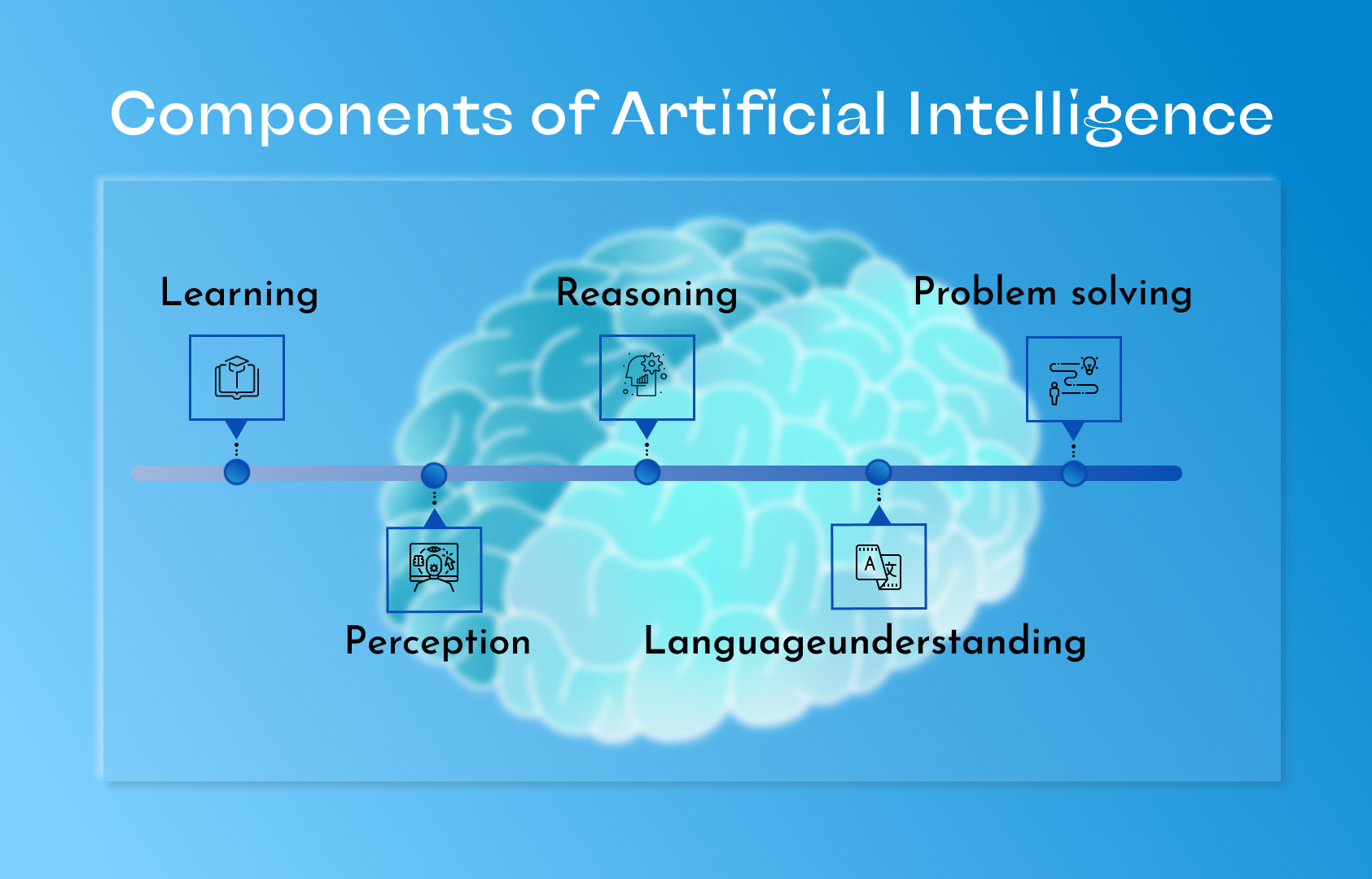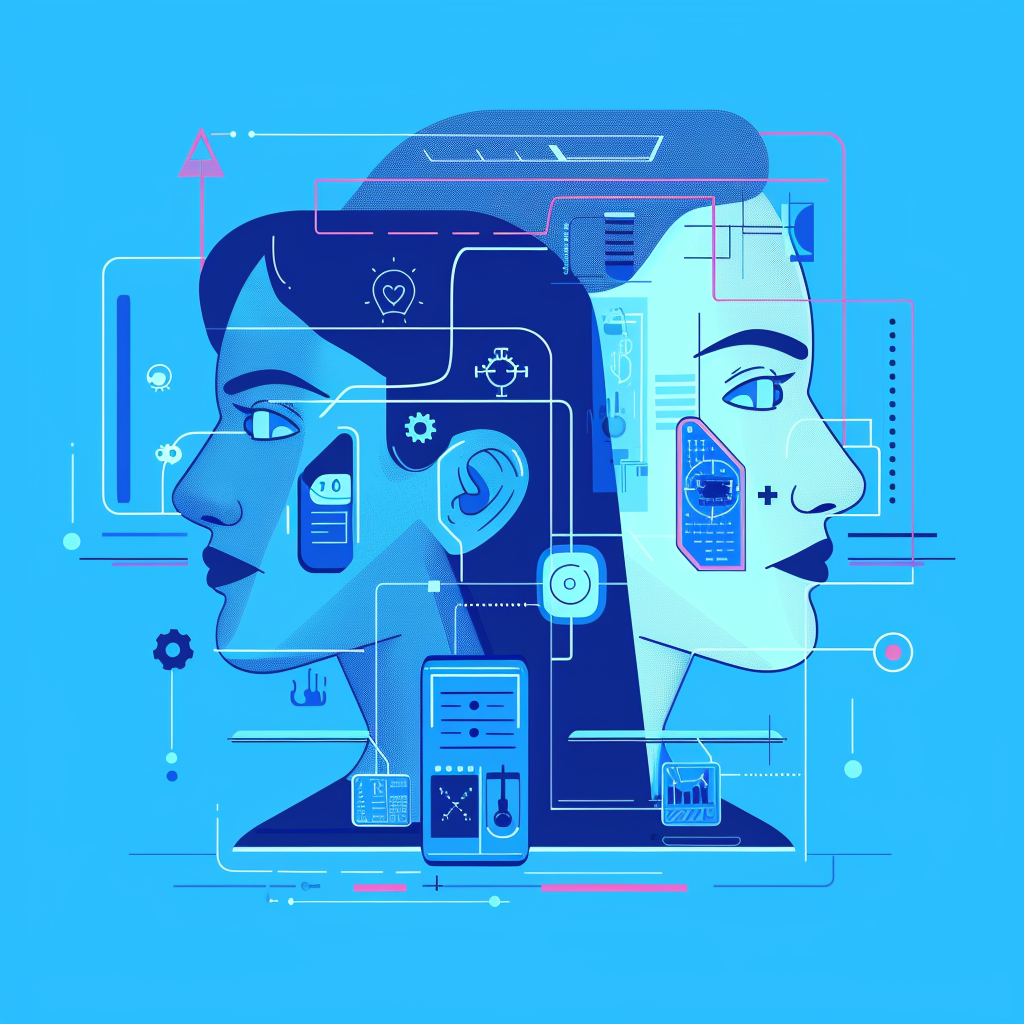Did you know that by 2025, it’s estimated that 80% of enterprises will be using some form of Artificial Intelligence (AI) technology? Take Netflix, for example–their AI algorithms power personalized recommendations, suggesting movies and shows you’re likely to enjoy.
Intrigued by the potential of AI and ready to build your own AI app? This comprehensive guide will equip you with the knowledge to navigate AI app development step-by-step. We’ll delve into everything from defining your app’s goals to integrating your AI model and ensuring seamless functionality.

AI App Development: Overview
Artificial intelligence (AI) is rapidly transforming the way we live, work, and interact with technology. This transformation extends to the mobile app landscape, where AI-powered applications are surging in popularity.
According to a source, the global mobile AI market is expected to grow to a staggering $84.80 billion by 2030, reflecting a compound annual growth rate (CAGR) of 26.44%. Several factors fuel this surge in the AI app development market:
- Enhanced User Experiences: AI personalizes app experiences, tailors recommendations, and anticipates user needs, leading to higher engagement and satisfaction.
- Improved Functionality: AI-powered features like image recognition, voice search, and chatbots automate tasks and streamline user interactions within apps.
- Data-Driven Insights: AI analyzes user behavior and app data, enabling developers to continuously refine features and optimize app performance.
Real-world examples showcase the diverse applications of AI in mobile apps:
- Retail: AI assistants in shopping apps answer customer queries, recommend products, and personalize shopping journeys (e.g., WeChat, Sephora).
- Finance: AI-powered fraud detection systems in eCommerce apps protect users and streamline financial transactions (e.g., PayPal, Venmo).
- Entertainment: AI algorithms curate personalized content recommendations on streaming platforms (e.g., Netflix, Spotify).
- Healthcare: AI chatbots in healthcare offer symptom analysis and triage support, while AI-powered diagnostics assist medical professionals (e.g., Ada, Babylon Health).
As AI app creation continues to evolve and become more accessible, we can expect even more innovative AI applications to emerge. These applications will shape the future of mobile app development and transform the way we interact with technology on a daily basis.
Main Components of AI
Artificial intelligence (AI) has permeated nearly every facet of our lives, from facial recognition software to chatbots and recommendation engines. But what powers these seemingly magical functionalities? At the heart of every AI system lies a complex interplay between several fundamental components.

Learning
This cornerstone empowers AI systems to continuously acquire knowledge and improve their performance over time. Two primary learning paradigms exist: supervised learning, where AI models are trained on labeled data sets (e.g., identifying cats in pictures), and unsupervised learning, where they discover patterns in unlabeled data (e.g., recommending similar products based on past purchases).
Reasoning
This capability enables AI systems to draw logical conclusions and make informed decisions based on the knowledge they have acquired. Reasoning techniques encompass logical inference, where the system applies established rules to reach a conclusion, and probabilistic reasoning, which involves weighing the likelihood of various outcomes based on available data.
Problem-solving
This faculty equips AI systems to analyze situations, define goals, and develop effective strategies to achieve them. Problem-solving algorithms often involve heuristic search techniques, where the system explores a solution space to find an optimal path, or adaptation techniques, where the system modifies existing solutions to address new challenges.
Perception
This component allows AI systems to interpret and understand the surrounding environment through various sensors. Perception encompasses tasks like image recognition (identifying objects in a picture), object detection (locating specific objects within an image), and speech recognition (converting spoken language into text).
Language Understanding
This capability empowers AI systems to process and comprehend human language. Natural Language Processing (NLP) techniques enable AI systems to understand the meaning of sentences and generate human-like text. Tasks like sentiment analysis (determining the emotional tone of a piece of text) and machine translation (converting text from one language to another) fall under this umbrella.
The synergistic interplay of these core components fosters intelligent behavior in AI app creation. For instance, an AI-powered recommendation engine might leverage learning to remember your past preferences, reasoning to identify products you’re likely to enjoy, problem-solving to find relevant options within its database, perception to analyze product images and descriptions, and language understanding to interpret your search queries and generate personalized recommendations.

Key Elements of AI
While the core components of learning, reasoning, problem-solving, perception, and language understanding form the foundation of AI app creation, several key elements contribute to the immense capabilities of AI systems:
- Machine Learning: This is a type of artificial intelligence that allows computers to learn from data and improve their performance over time without being explicitly programmed. It’s like teaching a computer to recognize patterns and make decisions based on them. Our company provides an exceptional machine-learning service that you can use right now.
- Neural Networks: These are computer systems modeled after the human brain. They consist of interconnected nodes, or “neurons,” that work together to process and analyze information. Neural networks are commonly used in image recognition and natural language processing.
- Robotics: Robotics involves designing and building machines that can perform tasks autonomously or with minimal human intervention. Robots can range from simple devices like automated vacuum cleaners to sophisticated humanoid robots used in manufacturing and healthcare.
- Expert Systems: These are AI systems designed to replicate the decision-making abilities of human experts in a specific domain. They use a knowledge base and a set of rules to analyze data and provide recommendations or solutions to problems.
- Fuzzy Logic: Fuzzy logic is a mathematical framework for dealing with uncertainty and imprecision in data. Unlike traditional binary logic, which only recognizes true or false values, fuzzy logic allows for degrees of truth, which makes it useful in applications like control systems and decision-making.
- Natural Language Processing (NLP): This is a branch of AI app creation that focuses on enabling computers to understand, interpret, and generate human language. NLP is used in various applications, including virtual assistants, machine translation, and sentiment analysis.
How Does AI Work?
Artificial intelligence (AI) sometimes seems almost magical, mimicking human capabilities and seemingly conjuring intelligent behavior. But behind the scenes lies a fascinating interplay of algorithms, data, and computing power. Let’s dive into the core workings of AI and shed light on this remarkable technology.

The Power of Data
Data is the lifeblood of AI app creation. AI systems are trained on massive datasets, which can include text, images, videos, or numerical data. This data serves as the raw material from which AI systems learn and extract knowledge. The quality and quantity of data significantly impact the effectiveness of an AI system.
Learning Algorithms
AI utilizes various learning algorithms to process data and identify patterns. These algorithms are essentially sets of instructions that guide the AI system in its learning process. Two primary categories of learning algorithms exist:
- Supervised Learning. Imagine a teacher showing a student labeled examples (e.g., pictures of cats and dogs). Supervised learning works similarly, where the data is labeled, and the AI system learns to map the inputs (images) to the corresponding outputs (cat or dog).
- Unsupervised Learning. This approach is like giving a student a pile of unlabeled pictures and asking them to find patterns. Unsupervised learning algorithms can identify hidden patterns within unlabeled data, such as grouping similar images together without prior instruction.
The Role of Models
Through the learning process, AI systems develop models that represent the knowledge they have acquired from the data. These models can take various forms, such as mathematical equations or artificial neural networks (inspired by the structure of the human brain). The model essentially becomes the “engine” that allows the AI system to perform intelligent tasks.
Making Predictions and Decisions
Once an AI model is trained, it can be used to make predictions or decisions on new, unseen data. For instance, an image recognition model trained on millions of cat pictures can analyze a new image and determine with a high degree of accuracy whether it contains a cat. Similarly, a recommendation engine trained on user data can predict which products a user might be interested in based on their past purchases.
Continuous Learning
A hallmark of advanced AI systems is their ability to learn continuously. As AI systems encounter new data, they can refine their models and improve their performance. This allows AI systems to adapt to changing environments and become more effective at their designed tasks.
In essence, AI works by harnessing the power of data and sophisticated algorithms to learn, make predictions, and take intelligent actions. While the underlying technical details can be complex, understanding these core principles provides a solid foundation for appreciating the remarkable capabilities of AI technology.
How to Build an AI App?
The world of AI applications is booming, and you might be eager to join the revolution. But where do you begin? This step-by-step guide will equip you with the knowledge to navigate the AI app development process:
Define Your Goal and Target Audience:
- Identify the problem your AI app will solve. What specific needs are you addressing, and for whom?
- Clearly define the functionalities and value proposition of your app. How will your AI features benefit users?
- Price is an important factor in development. Our calculator can help you determine the price of your project.
Data Acquisition and Preparation:
- Gather high-quality data relevant to your app’s goal. Depending on your application, this might involve collecting user data, text data, images, or other data types.
- Ensure data quality and relevance. Clean and pre-process your data to remove errors, inconsistencies, and irrelevant information.
Choose the Right AI Model and Development Tools:
- Select an AI model type that aligns with your app’s functionality. Common choices include classification models (for tasks like image recognition), recommendation systems, or chatbots powered by natural language processing (NLP).
- Consider development tools and platforms. Explore cloud-based AI platforms or open-source frameworks that can streamline AI app development and provide access to pre-trained models.
Model Training and Optimization:
- Train your chosen AI model on your prepared data. This process involves feeding the data into the model and allowing it to learn and identify patterns.
- Monitor and optimize the training process. Evaluate the model’s performance and refine parameters to improve its accuracy and effectiveness.
Integration and Deployment:
- Integrate your trained AI model into your mobile app’s backend. This might involve building APIs (Application Programming Interfaces) to facilitate communication between the AI model and the app’s user interface.
- Deploy your app on relevant app stores (Apple App Store, Google Play Store). Ensure proper testing and quality assurance before making your app available to the public.
Continuous Improvement and Monitoring:
- Gather user feedback and app usage data. Analyze this data to identify areas for improvement and enhance the user experience of your AI app.
- Retrain and update your AI model over time. As you collect more data and user interactions, you can retrain your model to improve its performance and adapt to changing needs.
Building an AI app requires expertise and careful consideration. For complex AI app development projects, consider partnering with a leading company like LITSLINK. Their team of experienced professionals can guide you through each step, ensure a smooth development process, and bring your AI-powered vision to life.
Remember, this is a general roadmap. Specific steps may vary depending on the complexity of your AI app and the chosen development approach. With careful planning, execution, and potentially the support of an expert AI development partner, you can transform your innovative AI idea into a powerful and successful mobile application.
Conclusion
The world of AI applications is brimming with possibilities. From streamlining daily tasks to revolutionizing entire industries, AI has the potential to reshape our lives in profound ways. As you’ve learned in this guide, building an AI app can be challenging and rewarding.
The future of AI applications is bright. Are you ready to embrace its potential and become a part of this exciting technological revolution? If so, dust off your creative ideas, equip yourself with the knowledge you’ve gained, and embark on your journey to create an AI app that leaves a lasting impact.





